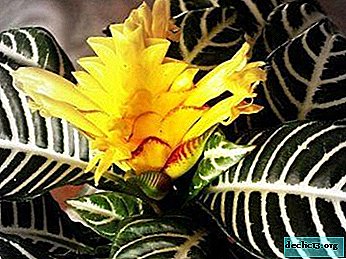Tropical Afelander at home. Photo plants and rules of care

Among the huge number of indoor flowers, the tropical plant of aphelander with bright inflorescences and variegated colored leaves stands out.
The name is formed by adding two Greek words: aphelis - simple and andros - man. In care, the plant is quite finicky.
If certain conditions are not created, then the afelander can wither and perish. Therefore, it is important to know how to properly care for the plant.
It is about caring for the plant at home, about possible diseases and pests, about combating them that will be discussed in the article.
Flower description
Afelandra is a tropical, hygrophilous and thermophilic plant of the acanthus family. It grows in tropical forests of North and South American countries, characterized by high humidity. There are by different standards from 50 to 195 varieties and species. Grown as decorative leaf and decorative flowering indoor shrub.
For indoor use low-growing varieties. In home floriculture it is considered difficult to grow, requiring special attention and care. If you fail to create the appropriate conditions, then the flower may die.Photo
Below are photos of this flower:




Growth Features
Afelandra is a stunted evergreen. When grown indoors, the flower reaches a height of no more than 30-90 cm. In nature, it is found, the squelar afelander, which reaches about 2 meters in height.
REFERENCE: The most common species that can grow and bloom at home, is considered an aphelander protruding and an aphelander orange.Home bush has large leaves having a glossy, smooth surface. The leaves are pointed round. The color is dark green with numerous yellow veins.
In early autumn or late spring, the afelander begins to bloom.. Long bracts in the shape of a regular rectangle are painted in bright yellow, orange or scarlet. Most often, asymmetrical flowers have four stamens and one pistil. Inflorescences of lilac, orange, purple, yellow. Afelander blooms for at least 2 months, but a maximum of 3.
At the end of the flowering period, a box with seeds is formed, which is divided into two parts. In each recess there are 2 seeds that are subsequently used to grow a new flower.
How to care at home?
Cultivating an afelander is a difficult task; the person who bought it must be prepared to pay maximum attention. This is a tropical plant, accustomed to heat, high humidity and light. It is strictly forbidden to allow the soil to dry out and temperature surges. If the plant is not provided with appropriate care, then the flower will cease to bloom, wither, or even die.
Temperature
Indoor air should be warm at any time of the year. The optimum temperature in the summer is 20-27 ° C. In winter, content is allowed at 15-20 degrees. Afelandra should be tucked away from direct sunlight. Located at the windows on the east or west side of the room.
In the summer, the flower can be taken out to the balcony, but protected from drafts and rainfall. In winter, a place with a flower should be lit as much as possible for this; fluorescent lamps are placed, if this is not done, the plant ceases to bloom.
Watering
 Water the plant abundantly, but without allowing moisture to stagnate in the soil. If excess water is found on the stand, it must be poured immediately. Recommended frequency of watering once every 3-4 days.
Water the plant abundantly, but without allowing moisture to stagnate in the soil. If excess water is found on the stand, it must be poured immediately. Recommended frequency of watering once every 3-4 days.
Spraying the plant in the summer is worth several times a day. In winter, growth time slows down, so water consumption is lower.
The level of air humidity in the room is desirable to maintain at least 60%, since in nature the afelander grows in tropical forests with high humidity and frequent rains. Water for irrigation should be soft and room temperature.
Water the plant should be careful not to let drops fall on the leaves.Pruning
Caring for afelandra at home is unthinkable without pruning. This procedure is carried out in order to give the flower more magnificent forms. Cut the plant at the end of winter, before the start of strong growth. All shoots are removed, leaving 20-25 cm of stump. To quickly restore the afelander, a plastic cap is put on the pot, after which they are often sprayed and aired.
The young plants only pinch the tops, giving the shoots a beautiful shape. If this is not done, then the flower, after a few years, will stretch out strongly, and the lower leaves will begin to fall off. During this period, the plant can be transplanted, the adult afelander is moved to a new pot every three years, and the young plant once a year. And also to update the soil for this remove the old layer and add fresh soil.
Soil and top dressing
Successful cultivation of afelander depends in many respects on the quality of the soil and top dressing with various fertilizers. What kind of purchased soil is suitable? The main thing is that the earth is loose and breathable. Fertilizers are applied every two weeks in the summer, once a month is enough in the winter.
The composition of the dressings needs to be adjusted in accordance with the needs of the afelander:
- When not blooming for a long time, it is worth increasing the amount of phosphorus and reducing the amount of nitrogen.
- Fallen leaves indicate a lack of potassium.
- Nitrogen dressing is added when grinding leaves.
If the ground is dry, then before applying fertilizer, the flower must be carefully watered, otherwise it is likely to receive a chemical burn.
 The following fertilizers are suitable for feeding afelander:
The following fertilizers are suitable for feeding afelander:
- Energy, 1 capsule per 1 liter of water.
- Agricole, 1 tbsp. spoon on 3 l of water. There is also fertilizer in the form of sticks, which are simply inserted into a flower pot. It dissolves within 1-2 months.
- Fertilizers from the Bona Forte or KOY REASIL series.
- Baikal EM-1 for indoor plants.
- In winter, it is well suited for fertilizing GUMI-OMI "Decorative-leafy" 1 teaspoon per 1 liter of pot volume.
Video about plant care:
Diseases and Pests
Afelandra, like any other plant, has its own diseases and pests. It is prone to the following diseases:
- Leaf fall. First of all, this happens if the flower does not receive the required amount of water and the roots subsequently begin to dry. Perhaps the reason was the low air temperature or drafts in the room in which the plant is located. As well as an excessive amount of direct sunlight falling on the afelander.
- Afelandra does not bloom. Very often, having bought a flowering plant in a store, at home it ceases to bloom. To prevent this from happening in the winter, the shrub needs to provide a rest period in cool and bright rooms, and even better, to root a new stem. Young afelander pleases with the beauty of yellow-orange inflorescences much more often.
- Brown colored steel leaf edges. There are two reasons for this disease:
- Leaf mold, upon the appearance of which it is necessary to remove damaged leaves and spray the entire flower with a fungicide solution.
- Insufficient air humidity. To eliminate, you can put the plant in a tray with wet sawdust.
- Brown spots appear over the entire surface of the sheet.. They appear due to the large amount of sunlight, it is necessary to remove the plant in the shade and lack of air, you will need frequent ventilation of the room.
- Plant fade, due to the constant presence in the draft. You should move the flower to another room.
Afelandra is affected by the following pests:
 The tips of young plants are amazing aphid. To eliminate it, drugs such as: Acarin, Spark Bio are well suited.
The tips of young plants are amazing aphid. To eliminate it, drugs such as: Acarin, Spark Bio are well suited.- Bottom surface of the sheet likes scale shield. You can determine it with the appearance of brown plaque and a sharp fall of the leaves. If only the first signs appeared, then for treatment it is enough to wipe the leaves with wet wipes. In severe cases, spraying with Fitoverm or Aktellik solutions will help.
- Mealybug. It is recognized by the whitish color on the leaves. For fighting, the same means are used as for scale insects.
Conclusion
Despite the fact that Afelandra is a tropical plant, very thermophilic and requiring constant maintenance of soil and air humidity, it is quite possible to cope with it. It is enough to provide proper care to the houseplant, then the afelander will be in great shape throughout the year.

 The tips of young plants are amazing aphid. To eliminate it, drugs such as: Acarin, Spark Bio are well suited.
The tips of young plants are amazing aphid. To eliminate it, drugs such as: Acarin, Spark Bio are well suited.















